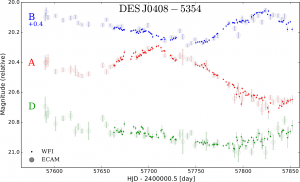Dear Observer,
Thanks for observing for us at the VATT. This page is made to help you with the observation of gravitational lenses for the COSMOGRAIL project, which is led by the Laboratory of Astrophysics of the École Polytechnique Fédérale de Lausanne (EPFL).
During your observing run, you will observe one gravitational lens every night. It should take you approximatively 30 minutes.
If you want to learn more about all the existing science that we are doing with the data you will take for us, you can explore the COSMOGRAIL and H0LiCOW wesite.
eCOSMOGRAIL
eCOSMOGRAIL, for extended COSMOGRAIL is the next big step forward concerning the time-delay measurements. Instead of monitoring the lensed QSOs over many years with ~2 observations per week, we aim at one observation per day with a increased signal-to-noise ratio, in order to get a precise and accurate measure of the time delays in less than a year. The regular sampling of our light curves is the key for the sucess of this programm.
The average expected time delays for the quasars monitored at the VATT telescope is ~30 days. The typical time-scale of the luminosity variations that we want to observe is in the order of a few days.

The figure above presents the light curves of DES J0408-5354 after six month of monitoring with WFI at the 2m2, located in La Silla, Chile (small dots) and eight months of monitoring with ECAM at the Euler Swiss Telescope (larger shallow dots, also located in La Silla). The sharp, well defined feature in the A and B light curves allowed us to measure a precise and accurate time delay from the WFI data, as presented in Courbin et al. 2017. A successful monitoring campaign like the one on DES J0408-5354 relies mainly on two key points:
- A long baseline of observations: we need to monitor the lensed images for a long enough period of time in order to catch as many luminosity variations as possible. Typically, we want to monitor for at least 5-6 times longer than the typical variations, which makes a minimum of six months of continuous monitoring.
- An high-cadence monitoring coupled with an extremely regular sampling: since we want to catch luminosity variations that lasts only a few days, we need enough points to properly sample these features in the light curves.
Thanks to the effort of the STRIDES collaboration, this object allowed a 3.9% precision measurement of the Hubble constant.